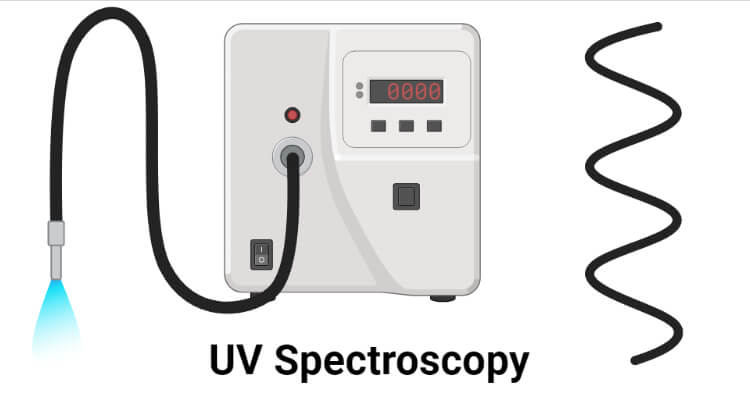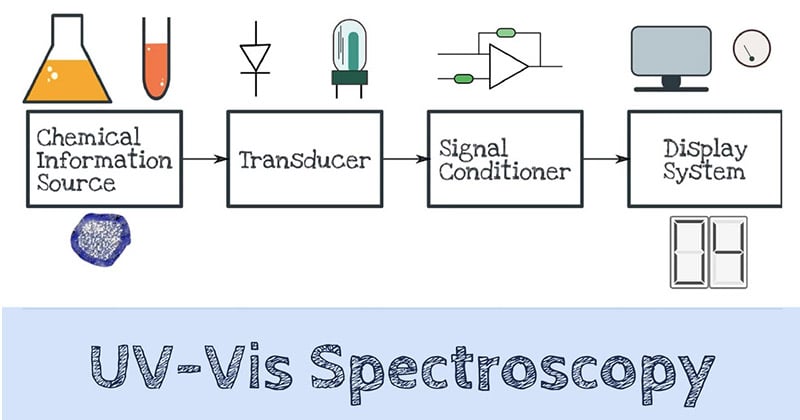Interesting Science Videos
What is UV Spectroscopy?
Spectroscopy is the measurement and interpretation of electromagnetic radiation absorbed or emitted when the molecules or atoms or ions of a sample move from one energy state to another energy state. UV spectroscopy is a type of absorption spectroscopy in which light of the ultra-violet region (200-400 nm) is absorbed by the molecule which results in the excitation of the electrons from the ground state to a higher energy state.

Principle of UV Spectroscopy
- Basically, spectroscopy is related to the interaction of light with matter.
- As light is absorbed by matter, the result is an increase in the energy content of the atoms or molecules.
- When ultraviolet radiations are absorbed, this results in the excitation of the electrons from the ground state towards a higher energy state.
- Molecules containing π-electrons or nonbonding electrons (n-electrons) can absorb energy in the form of ultraviolet light to excite these electrons to higher anti-bonding molecular orbitals.
- The more easily excited the electrons, the longer the wavelength of light they can absorb. There are four possible types of transitions (π–π*, n–π*, σ–σ*, and n–σ*), and they can be ordered as follows: σ–σ* > n–σ* > π–π* > n–π*
- The absorption of ultraviolet light by a chemical compound will produce a distinct spectrum that aids in the identification of the compound.
Instrumentation or Parts of UV Spectroscopy
Light Source
- Tungsten filament lamps and Hydrogen-Deuterium lamps are the most widely used and suitable light sources as they cover the whole UV region.
- Tungsten filament lamps are rich in red radiations; more specifically they emit the radiations of 375 nm, while the intensity of Hydrogen-Deuterium lamps falls below 375 nm.
Monochromator
- Monochromators generally are composed of prisms and slits.
- Most of the spectrophotometers are double beam spectrophotometers.
- The radiation emitted from the primary source is dispersed with the help of rotating prisms.
- The various wavelengths of the light source which are separated by the prism are then selected by the slits such the rotation of the prism results in a series of continuously increasing wavelengths to pass through the slits for recording purposes.
- The beam selected by the slit is monochromatic and further divided into two beams with the help of another prism.
Sample and reference cells
- One of the two divided beams is passed through the sample solution and the second beam is passé through the reference solution.
- Both sample and reference solution is contained in the cells.
- These cells are made of either silica or quartz. Glass can’t be used for the cells as it also absorbs light in the UV region.
Detector
- Generally, two photocells serve the purpose of the detector in UV spectroscopy.
- One of the photocells receives the beam from the sample cell and the second detector receives the beam from the reference.
- The intensity of the radiation from the reference cell is stronger than the beam of the sample cell. This results in the generation of pulsating or alternating currents in the photocells.
Amplifier
- The alternating current generated in the photocells is transferred to the amplifier.
- The amplifier is coupled to a small servometer.
- Generally, the current generated in the photocells is of very low intensity, the main purpose of the amplifier is to amplify the signals many times so we can get clear and recordable signals.
Recording devices
- Most of the time amplifier is coupled to a pen recorder which is connected to the computer.
- The computer stores all the data generated and produces the spectrum of the desired compound.

Image Source: Practical Ninjas.
Applications of UV Spectroscopy
Detection of Impurities
- It is one of the best methods for the determination of impurities in organic molecules.
- Additional peaks can be observed due to impurities in the sample and it can be compared with that of standard raw material.
- By also measuring the absorbance at a specific wavelength, the impurities can be detected.
Structure elucidation of organic compounds
It is useful in the structure elucidation of organic molecules, such as in detecting the presence or absence of unsaturation, the presence of heteroatoms.
- UV absorption spectroscopy can be used for the quantitative determination of compounds that absorb UV radiation.
- UV absorption spectroscopy can characterize those types of compounds that absorb UV radiation thus used in the qualitative determination of compounds. Identification is done by comparing the absorption spectrum with the spectra of known compounds.
- This technique is used to detect the presence or absence of a functional group in the compound. The absence of a band at a particular wavelength is regarded as evidence for the absence of particular group.
- Kinetics of reaction can also be studied using UV spectroscopy. The UV radiation is passed through the reaction cell and the absorbance changes can be observed.
- Many drugs are either in the form of raw material or in the form of the formulation. They can be assayed by making a suitable solution of the drug in a solvent and measuring the absorbance at a specific wavelength.
- Molecular weights of compounds can be measured spectrophotometrically by preparing the suitable derivatives of these compounds.
- UV spectrophotometer may be used as a detector for HPLC.
References
- http://www.indiastudychannel.com/resources/146681-Principle-working-and-applications-of-UV-spectroscopy.aspx
- https://www.slideshare.net/AlexaJacob1/uv-visible-spectroscopy-ppt
- https://www.slideshare.net/manishpharma/application-of-uv-spectroscopy
- https://medium.com/@ankur1857/principle-of-ultra-violet-uv-spectrophotometer-e6a1c435d258
- https://en.wikipedia.org/wiki/Ultraviolet%E2%80%93visible_spectroscopy

Do we have any Spectroscopy Equipment for Sound Vibrations? How to assess the changes which occurs at Molecular level through Sound Vibrations?
HPLC me lamp kitne hote h aur unka name kya h
UV me lamp kitne hote h aur unka name kya h
Was reading this just to find out my lecturer gave us this exact same notes.Amazing!!
How to handle Uv method software and HPLC Shimadzu and Agilent
Preparing of samples and different mobile phase for HPLC
Assay and Disso for UV
Good description
very nice helped in study of analysis
a very easy short form